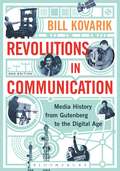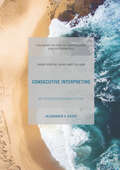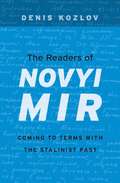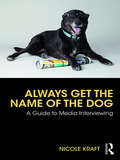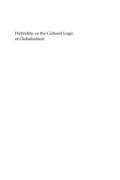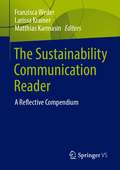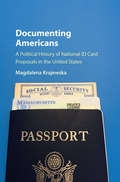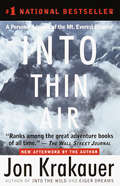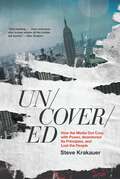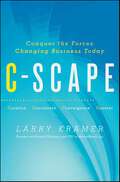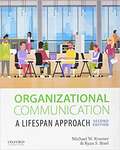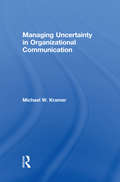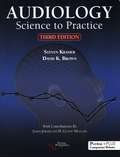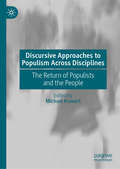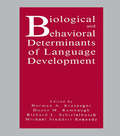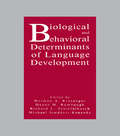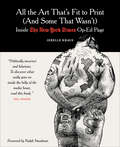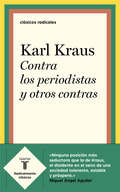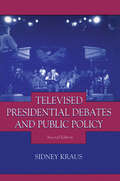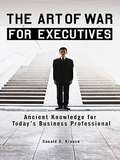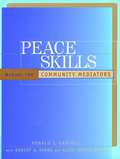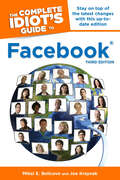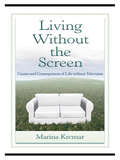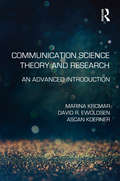- Table View
- List View
Revolutions In Communication: Media History From Gutenberg To The Digital Age
by Bill KovarikRevolutions in Communication offers a new approach to media history, presenting an encyclopedic look at the way technological change has linked social and ideological communities. Using key figures in history to benchmark the chronology of technical innovation, Kovarik's exhaustive scholarship narrates the story of revolutions in printing, electronic communication and digital information, while drawing parallels between the past and present. Updated to reflect new research that has surfaced these past few years, Revolutions in Communication continues to provide students and teachers with the most readable history of communications, while including enough international perspective to get the most accurate sense of the field. The supplemental reading materials on the companion website include slideshows, podcasts and video demonstration plans in order to facilitate further reading.
Consecutive Interpreting
by Alexander V. KozinThis book sheds light on the phenomenon of consecutive interpreting. It combines phenomenological and empirical analyses to build a communication theory of interpreting. The author begins by reviewing mainstream research on consecutive interpreting and then dissociates himself from it, conducting a three-tier analysis of interpreting data. He concludes by presenting an alternative theory of consecutive interpreting. As he makes clear from the outset, a new and combined methodology for consecutive interpreting needs to be constructed to satisfy both the relation of the phenomenon to experience as well as its social foundation. He also stresses the potential within the humanities for wider employment of the phenomenological empirical method. This book will appeal to students and scholars of linguistics, translation, phenomenology, social interaction and communication
The Readers of Novyi Mir
by Denis KozlovIn the “Thaw” following Stalin’s death, probing conversations about the nation’s violent past took place in the literary journal Novyi mir (New World). Readers’ letters reveal that discussion of the Terror was central to intellectual and political life during the USSR’s last decades. Denis Kozlov shows how minds change, even in a closed society.
Always Get the Name of the Dog: A Guide to Media Interviewing
by Nicole KraftAlways Get the Name of the Dog is a guide to journalistic interviewing, written by a journalist, for journalists. It features advice from some of the best writers and reporters in the business, and takes a comprehensive view of media interviewing across multiple platforms, while emphasizing active learning to give readers actionable steps to become great media interviewers. Through real scenarios and examples, this text takes future journalists through the steps of the interview, from research to source identification to question development and beyond. Whether you are a journalism student or an experienced reporter looking to sharpen your skills, this text can help make sure you get all you need from every interview you conduct.
Hybridity, or the Cultural Logic of Globalization
by Kraidy Marwan M.The intermingling of people and media from different cultures is a communication-based phenomenon known as hybridity. Drawing on original research from Lebanon to Mexico and analyzing the use of the term in cultural and postcolonial studies (as well as the popular and business media), Marwan Kraidy offers readers a history of the idea and a set of prescriptions for its future use. Kraidy analyzes the use of the concept of cultural mixture from the first century A. D. to its present application in the academy and the commercial press. The book's case studies build an argument for understanding the importance of the dynamics of communication, uneven power relationships, and political economy as well as culture, in situations of hybridity. Kraidy suggests a new framework he developed to study cultural mixture-called critical transculturalism-which uses hybridity as its core concept, but in addition, provides a practical method for examining how media and communication work in international contexts.
The Sustainability Communication Reader: A Reflective Compendium
by Larissa Krainer Matthias Karmasin Franzisca WederThe Textbook seeks for an innovative approach to Sustainability Communication as transdisciplinary area of research. Following the United Nations Sustainable Development Goals, which are intended to transform the world as it is known, we seek for a multidisciplinary discussion of the role communication plays in realizing these goals. With complementing theoretical approaches and concepts, the book offers various perspectives on communication practices and strategies on an individual, organizational, institutional, as well as public level that contribute, enable (or hinder) sustainable development. Presented case studies show methodological as well as issue specific challenges in sustainability communication. Therefore, the book introduces and promotes innovative methods for this specific area of research.
Documenting Americans: A Political History of National ID Card Proposals in the United States
by Magdalena KrajewskaThis is the first and only comprehensive, book-length political history of national ID card proposals and developments in identity policing in the United States. The book focuses on the period from 1915 to 2016, including the post-9/11 debates and policy decisions regarding the introduction of technologically-advanced identification documents. Putting the United States in comparative perspective and connecting the vital issues of immigration and homeland security, Magdalena Krajewska shows how national ID card proposals have been woven into political conflict across a variety of policy fields. Findings contradict conventional wisdom, debunking two common myths: that Americans are opposed to national ID cards and that American policymakers never propose national ID cards. Dr Krajewska draws on extensive archival research; high-level interviews with politicians, policymakers, and ID card technology experts in Washington, DC and London; and public opinion polls.
Into Thin Air: A Personal Account Of The Mount Everest Disaster (Sparknotes Literature Guide Ser.)
by Jon Krakauer#1 NATIONAL BESTSELLER • The epic account of the storm on the summit of Mt. Everest that claimed five lives and left countless more—including Krakauer's—in guilt-ridden disarray. "A harrowing tale of the perils of high-altitude climbing, a story of bad luck and worse judgment and of heartbreaking heroism." —PEOPLE A bank of clouds was assembling on the not-so-distant horizon, but journalist-mountaineer Jon Krakauer, standing on the summit of Mt. Everest, saw nothing that "suggested that a murderous storm was bearing down." He was wrong. By writing Into Thin Air, Krakauer may have hoped to exorcise some of his own demons and lay to rest some of the painful questions that still surround the event. He takes great pains to provide a balanced picture of the people and events he witnessed and gives due credit to the tireless and dedicated Sherpas. He also avoids blasting easy targets such as Sandy Pittman, the wealthy socialite who brought an espresso maker along on the expedition. Krakauer's highly personal inquiry into the catastrophe provides a great deal of insight into what went wrong. But for Krakauer himself, further interviews and investigations only lead him to the conclusion that his perceived failures were directly responsible for a fellow climber's death. Clearly, Krakauer remains haunted by the disaster, and although he relates a number of incidents in which he acted selflessly and even heroically, he seems unable to view those instances objectively. In the end, despite his evenhanded and even generous assessment of others' actions, he reserves a full measure of vitriol for himself. This updated trade paperback edition of Into Thin Air includes an extensive new postscript that sheds fascinating light on the acrimonious debate that flared between Krakauer and Everest guide Anatoli Boukreev in the wake of the tragedy. "I have no doubt that Boukreev's intentions were good on summit day," writes Krakauer in the postscript, dated August 1999. "What disturbs me, though, was Boukreev's refusal to acknowledge the possibility that he made even a single poor decision. Never did he indicate that perhaps it wasn't the best choice to climb without gas or go down ahead of his clients." As usual, Krakauer supports his points with dogged research and a good dose of humility. But rather than continue the heated discourse that has raged since Into Thin Air's denouncement of guide Boukreev, Krakauer's tone is conciliatory; he points most of his criticism at G. Weston De Walt, who coauthored The Climb, Boukreev's version of events. And in a touching conclusion, Krakauer recounts his last conversation with the late Boukreev, in which the two weathered climbers agreed to disagree about certain points. Krakauer had great hopes to patch things up with Boukreev, but the Russian later died in an avalanche on another Himalayan peak, Annapurna I. In 1999, Krakauer received an Academy Award in Literature from the American Academy of Arts and Letters--a prestigious prize intended "to honor writers of exceptional accomplishment." According to the Academy's citation, "Krakauer combines the tenacity and courage of the finest tradition of investigative journalism with the stylish subtlety and profound insight of the born writer. His account of an ascent of Mount Everest has led to a general reevaluation of climbing and of the commercialization of what was once a romantic, solitary sport; while his account of the life and death of Christopher McCandless, who died of starvation after challenging the Alaskan wilderness, delves even more deeply and disturbingly into the fascination of nature and the devastating effects of its lure on a young and curious mind."
Uncovered: How the Media Got Cozy with Power, Abandoned Its Principles, and Lost the People
by Steve KrakauerFrom the COVID lab leak theory to Hunter Biden's laptop to Jeffrey Epstein, media critic and former CNN producer Steve Krakauer spotlights the problems of a news industry filled with geographically isolated, introspection-free, egomaniacal journalists. In Uncovered, America&’s sharpest media critic, former CNN insider Steve Krakauer, reveals exactly what went wrong—and why the media went off the rails. The fourth estate is supposed to be a conduit to the people and a check on power. But instead, we have geographically isolated, introspection-free, cozy-with-power, egomaniacal journalists thirsty for elite approval. Krakauer dives deep into some of the most egregious examples of the elite censorship collusion racket, like how tech suppression and media fear led to the New York Post-Hunter Biden email debacle before the 2020 election. Krakauer takes readers inside CNN after the shock Trump election, inside the New York Times after the Tom Cotton op-ed backlash, inside ESPN after the shift away from sports-only coverage, and more. No one understands these problems (and people) better than Krakauer. He has spent years getting to know the most influential players in the industry and this fascinating book is what he&’s learned. But most importantly, Krakauer equips readers with the crucial tools to sniff out when the press is lying or misleading the people of America in the future—so together, we can bypass them altogether. "Steve Krakauer's new book, Uncovered, is vital reading. It's the best and most perceptive deep dive into legacy media bias out there, from someone who knows where all the bodies are buried." ― Ben Shapiro "One of the most insightful critiques that has been published on this topic in years." ― Glenn Greenwald
C-Scape: Conquer the Forces Changing Business Today
by Larry Kramer“[Larry Kramer’s] MarketWatch.com is not just my favorite business website, it’s my personal homepage.” —Warren Buffett“[Larry Kramer] is the toughest and most ethical foe imaginable. His observations reflect a deep understanding of how the media works and what consumers want.” —Jim CramerFrom Larry Kramer, the founder of MarketWatch.com and former president of CBS Digital Media, comes a bold, pioneering report on what businesses must do to survive and thrive in the digital media revolution. Using case studies of companies such as Apple, Procter & Gamble, Netflix, and GE, Kramer not only draws a clear map of twenty-first century commerce, but charts the way forward. Readers wondering how to implement digital-age business strategies like those found in Clay Shirky’s Here Comes Everybody, Chris Anderson’s The Long Tail, or Jeff Jarvis’ What Would Google Do, look no further than Kramer’s groundbreaking C-Scape.
Organizational Communication: A Lifespan Approach
by Michael Kramer Ryan BiselOrganizational Communication: A Lifespan Approach is a student-focused introduction to the field. Featuring real-world stories, helpful and unique illustrations, and practical applications of theory, this text engages students and shows them how to apply concepts, theories, and perspectives in every chapter. Organizational Communication helps students understand their communication as participants in organizations throughout their lifetimes. It begins with how pre-career experiences influence our expectations for organizational experiences and ends with organizational exits, including retirement. This approach provides a seamless integration of theory and application while helping students at any stage of life reflect on past experiences, prepare for new endeavors and roles, and understand vital organizational theories and perspectives in new and concrete ways.
Managing Uncertainty in Organizational Communication (Routledge Communication Series)
by Michael W. KramerIn this book, Michael W. Kramer applies uncertainty reduction theory (URT)--a key theory in current communication scholarship--to the context of organizational communication. Examining URT and the range of research applicable to organizational settings, Kramer proposes a groundbreaking theory of managing uncertainty (TMU), which synthesizes prior research while also addressing its criticisms. Examples are provided to illustrate the principles of the TMU at both the individual and collective (group/organizational) levels of analysis. Original studies based on the theory show that it provides a useful extension of URT, addressing some concerns raised by critics of that earlier model. Kramer illustrates that, as a model in progress, TMU will change as new research and insights build upon it. Managing Uncertainty in Organizational Communication assists readers in understanding and researching uncertainty in communication, which encourages additional changes and improvements to the model. It is of primary interest to scholars, researchers, and practitioners in organizational, interpersonal, and group communication.
Audiology: Science to Practice
by Steven Kramer David K. Brown<p>Audiology: Science to Practice, Third Edition is a comprehensive and challenging textbook for undergraduate students in audiology and hearing science, for graduate students beginning an AuD program, especially those who may not have a background in the subject, and for other health care professionals who would benefit by a better understanding of hearing science and audiology practices. This textbook is written in a style that tries to make new or difficult concepts relatively easy to understand. The approach is to keep it readable and to punctuate the text with useful figures and tables. <p>This textbook seeks to provide a solid foundation in hearing science and clinical audiology, and is an excellent resource for those preparing for the Audiology Praxis Exam. It also serves as a companion to the Audiology Workbook, Third Edition, by Dr. Steven Kramer and Dr. Larry Small. From science to practice, this textbook covers anatomy and physiology of the auditory and vestibular systems, acoustic properties and perception of sounds, audiometry and speech measures, audiogram interpretations, masking, outer and middle ear assessments, otoacoustic emissions and auditory brainstem responses, hearing screening, hearing aids, cochlear and other implantable devices, and auditory disorders supported with expected audiologic data. The reader is also introduced to the profession of audiology and what it means to work as an audiologist. Where appropriate, variations in procedures for pediatrics are presented.</p>
Discursive Approaches to Populism Across Disciplines: The Return of Populists and the People
by Michael KranertThis edited book presents a cross-disciplinary and international conversation about the discursive nature of ‘populist’ politics. Based on the idea that language and meaning making are central to the political process, the authors present research originating from disciplines such as sociology, political science, linguistics, gender studies and education, giving credence to the variety and context dependence of both populist discourse and its analysis. Using a variety of different theoretical frames, the volume examines international case studies from Europe, Africa, Asia and the Americas, looking at different modes of populism as well as the interaction of populism with other ideologies and belief systems. The chapters draw on several disciplines, and will be of interest to scholars working in linguistics, political studies, journalism, rhetoric and discourse analysis.
Biological and Behavioral Determinants of Language Development
by Norman A. Krasnegor Duane M. Rumbaugh Richard L. Schiefelbusch Michael Studdert-KennedyThis book presents a current, interdisciplinary perspective on language requisites from both a biological/comparative perspective and from a developmental/learning perspective. Perspectives regarding language and language acquisition are advanced by scientists of various backgrounds -- speech, hearing, developmental psychology, comparative psychology, and language intervention. This unique volume searches for a rational interface between findings and perspectives generated by language studies with humans and with chimpanzees. Intended to render a reconsideration as to the essence of language and the requisites to its acquisition, it also provides readers with perspectives defined by various revisionists who hold that language might be other than the consequence of a mutation unique to humans and might, fundamentally, not be limited to speech.
Biological and Behavioral Determinants of Language Development
by Norman A. Krasnegor Duane M. Rumbaugh Richard L. Schiefelbusch Michael Studdert-KennedyThis book presents a current, interdisciplinary perspective on language requisites from both a biological/comparative perspective and from a developmental/learning perspective. Perspectives regarding language and language acquisition are advanced by scientists of various backgrounds -- speech, hearing, developmental psychology, comparative psychology, and language intervention. This unique volume searches for a rational interface between findings and perspectives generated by language studies with humans and with chimpanzees. Intended to render a reconsideration as to the essence of language and the requisites to its acquisition, it also provides readers with perspectives defined by various revisionists who hold that language might be other than the consequence of a mutation unique to humans and might, fundamentally, not be limited to speech.
All the Art That's Fit to Print (And Some That Wasn't): Inside The New York Times Op-Ed Page
by Jerelle KrausAll the Art That's Fit to Print reveals the true story of the world's first Op-Ed page, a public platform that—in 1970—prefigured the Internet blogosphere. Not only did the New York Times's nonstaff bylines shatter tradition, but the pictures were revolutionary. Unlike anything ever seen in a newspaper, Op-Ed art became a globally influential idiom that reached beyond narrative for metaphor and changed illustration's very purpose and potential. Jerelle Kraus, whose thirteen-year tenure as Op-Ed art director far exceeds that of any other art director or editor, unveils a riveting account of working at the Times. <P><P>Her insider anecdotes include the reasons why artist Saul Steinberg hated the Times, why editor Howell Raines stopped the presses to kill a feature by Doonesbury's Garry Trudeau, and why reporter Syd Schanburg-whose story was told in the movie The Killing Fields-stated that he would travel anywhere to see Kissinger hanged, as well as Kraus's tale of surviving two and a half hours alone with the dethroned peerless outlaw, Richard Nixon.All the Art features a satiric portrayal of John McCain, a classic cartoon of Barack Obama by Jules Feiffer, and a drawing of Hillary Clinton and Obama by Barry Blitt. But when Frank Rich wrote a column discussing Hillary Clinton exclusively, the Times refused to allow Blitt to portray her. Nearly any notion is palatable in prose, yet editors perceive pictures as a far greater threat. Confucius underestimated the number of words an image is worth; the thousand-fold power of a picture is also its curse.Op-Ed's subject is the world, and its illustrations are created by the world's finest graphic artists. The 142 artists whose work appears in this book hail from thirty nations and five continents, and their 324 pictures-gleaned from a total of 30,000-reflect artists' common drive to communicate their creative visions and to stir our vibrant cultural-political pot.
All the Art That's Fit to Print (And Some That Wasn't): Inside The New York Times Op-Ed Page
by Jerelle KrausFrom the New York Times&’s former Op-Ed art director, the true story of the world&’s first Op-Ed page, a public platform that prefigured the blogosphere. Jerelle Kraus, whose thirteen-year tenure as Op-Ed art director far exceeds that of any other art director or editor, unveils a riveting account of working at the Times. Her insider anecdotes include the reasons why artist Saul Steinberg hated the Times, why editor Howell Raines stopped the presses to kill a feature by Doonesbury&’s Garry Trudeau, and why reporter Syd Schanburg—whose story was told in the movie The Killing Fields—stated that he would travel anywhere to see Kissinger hanged, as well as Kraus&’s tale of surviving two and a half hours alone with the dethroned outlaw, Richard Nixon. All the Art features a satiric portrayal of John McCain, a classic cartoon of Barack Obama by Jules Feiffer, and a drawing of Hillary Clinton and Obama by Barry Blitt. But when Frank Rich wrote a column discussing Hillary Clinton exclusively, the Times refused to allow Blitt to portray her. Nearly any notion is palatable in prose, yet editors perceive pictures as a far greater threat. Confucius underestimated the number of words an image is worth; the thousand-fold power of a picture is also its curse . . . Features 142 artists from thirty nations and five continents, and 324 pictures—gleaned from a total of 30,000—that stir our cultural-political pot. &“To discover what really goes on inside the belly of the media beast, read this book.&” —Bill Maher &“In this overflowing treasure chest of ideas, politics and cultural critiques, Kraus proves that &“art is dangerous&” and sometimes necessarily so.&” —Publishers Weekly
Contra los periodistas y otros contras
by Karl Kraus«Ninguna posición más seductora que la de Kraus, el disidente en el seno de una sociedad tolerante, estable y próspera.»Miguel Ángel Aguilar «Quien sea capaz de escribir aforismos no debiera desparramarse en artículos», afirma Karl Kraus, quien con gran inteligencia, ironía y capacidad de síntesis se despachó en estos textos contra la moral imperante, los políticos, la religión, la decadencia de la cultura y del lenguaje, los estetas, y por supuesto los periodistas y los medios de comunicación. Deslumbrantes, oportunas, a veces irritantes y siempre impertinentes, sus advertencias resuenan furiosamente en nuestro presente. Karl Kraus (Ji?ín, actual República Checa, 1874 - Viena, 1936) fue un eminente escritor y periodista conocido como ensayista, aforista, dramaturgo y poeta. Gran polemista, tuvo por principal arma Die Fackel, revista de gran audiencia que editó y escribió casi en solitario desde 1899 y durante treinta y siete años. Figuras como Schönberg, Musil, Canetti, Wittgenstein o Adorno esperaban impacientes la aparición del siguiente número. Reseñas:«Ninguna posición más seductora que la de Kraus, el disidente en el seno de una sociedad tolerante, estable y próspera.»Miguel Ángel Aguilar «Los periodistas representan la relajación del estilo y la falta de moralidad de la profesión. Kraus es el redentor; mientras Kraus exista y fulmine, todo está controlado.»Robert Musil «El mayor satírico en lengua alemana del siglo XX.»Isidoro Reguera
Televised Presidential Debates and Public Policy: Televised Presidential Debates And Public Policy (Communication and Society)
by Sidney KrausWith this second edition, Kraus continues his examination of formal presidential debates, considering the experience of television in presidential elections, reviewing what has been learned about televised debates, and evaluating that knowledge in the context of the election process, specifically, and the political process, generally. He also examines the media and the role they occupy in presidential elections. Because critics often refer to the Lincoln-Douglas debates when reproaching presidential debates, comparisons of the two are discussed throughout the book. Much of the data and information for this accounting of televised presidential debates comes from the author's first-hand experience as one who was involved with these debates as a participant observer, on site at nearly all of the debates discussed. Throughout these discussions, emphasis is placed on the implications for public policy. To suggest policy that will be accepted and adopted by politicians and the public is, at best, difficult. Proposals for changes in public policy based on experience -- even when scientific data support those changes -- must be subjected to an assessment of the values and predispositions of the proponent. These values and predispositions, however, may not necessarily inhibit the proponent's objectivity. As such, this review of television use in the presidential election process provides the context for examining televised debates.
The Art of War for Executives
by Krause Donald G.The first book to provide a clear easy-to-follow interpretation of Sun Tzu's classic document. The Art of War for Executives shows how to win on the battlefield of business.
Peace Skills: Manual for Community Mediators
by Ronald Kraybill Alice Evans Robert EvansHow to be a "peacebuilder" and mediate between conflicted entities.
The Complete Idiot's Guide to Facebook, 3rd Edition: Stay on Top of the Latest Changes with This Up-to-Date Edition
by Joe Kraynak Mikal E. BelicoveFacebook is by far the most popular social networking site, but it is not as user-friendly as the service would like people to think. It leaves many users scratching their heads over even the most fundamental features, such as the difference between their Wall and their News Feed. And Facebook's help system is woefully inadequate. The Complete Idiot's Guide® to Facebook, Third Edition, gets readers registered and touring Facebook in the very first chapter and never lets up as it reveals the features that have made Facebook so amazingly popular. Users discover how to:- Flesh out and protect the all new personal profile- Track down long lost friends, family members, and classmates- Communicate via status updates, email, and chat- Share photos and video- Make the best use of the new Timeline feature- Take advantage of Facebook's new location-based functionality- Schedule real world get-togethers and send out invitations- Share common interests in groups- Play games- Understand Facebook's dizzying array of privacy options that dictate who sees one's content- Buy and sell stuff in the Facebook Marketplace, and more.Readers also learn how to tap the power of Facebook for more than simply personal use-such as personal branding; marketing a business, product, service, or non profit; or promoting a worthy cause.
Living Without the Screen: Causes and Consequences of Life without Television
by Marina KrcmarLiving Without the Screen provides an in-depth study of those American families and individuals who opt not to watch television, exploring the reasons behind their choices, discussing their beliefs about television, and examining the current role of television in the American family. Author Marina Krcmar answers several questions in the volume: What is television? Who are those people who reject it? What are their reasons for doing so? How do they believe their lives are different because of this choice? What impact does this choice have on media research? This volume provides a current, distinctive, and important look at how personal choices on media use are made, and how these choices reflect more broadly on media’s place in today’s society. A compelling exploration of the motivations and rationales for those who choose to live without television, this book is a must-read for scholars and researchers working in children and media, media literacy, sociology, family studies and related areas. It will also be of interest to anyone with questions about media usage and the choices families make regarding the role of media in their lives.
Communication Science Theory and Research: An Advanced Introduction
by Marina Krcmar David R. Ewoldsen Ascan KoernerThis volume provides a graduate-level introduction to communication science, including theory and scholarship for masters and PhD students as well as practicing scholars. The work defines communication, reviews its history, and provides a broad look at how communication research is conducted. It also includes chapters reviewing the most frequently addressed topics in communication science. This book presents an overview of theory in general and of communication theory in particular, while offering a broad look at topics in communication that promote understanding of the key issues in communication science for students and scholars new to communication research. The book takes a predominantly "communication science" approach but also situates this approach in the broader field of communication, and addresses how communication science is related to and different from such approaches as critical and cultural studies and rhetoric. As an overview of communication science that will serve as a reference work for scholars as well as a text for the introduction to communication graduate studies course, this volume is an essential resource for understanding and conducting scholarship in the communication discipline.
